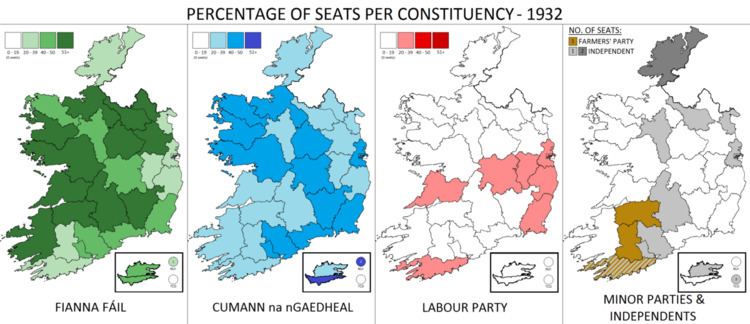16 February 1932 1933 → 26 March 1926 April 1923 57 65 | Turnout 76.5% 57 seats, 35.2% 61 seats, 38.6% 72 57 | |
 | ||
The Irish general election of 1932 was held on 16 February 1932, just over two weeks after the dissolution of the Dáil on 29 January. The newly elected 153 members of the 7th Dáil assembled at Leinster House on 9 March 1932 when the new President of the Executive Council and Executive Council of the Irish Free State were appointed by Governor-General James McNeill on the nomination of Dáil Éireann.
Contents
The general election took place in 30 parliamentary constituencies throughout the Irish Free State for 153 seats in the lower house of parliament, Dáil Éireann. The 1932 general election was one of the most important general elections held in Ireland in the 20th Century, resulting in the formation of the first Fianna Fáil government. Fianna Fáil became the largest party, and would be the largest party in Dáil Éireann and at every general election until 2011.
Cumann na nGaedheal
Cumann na nGaedheal fought the general election on its record of providing ten years of stable government. The party brought stability following the chaos of the Irish Civil War, and provided honest government. However, by 1932 this provision of solid government was wearing thin, particularly since the party had no solution to the collapse in trade which followed the depression of the early 1930s. Instead of offering new policies the party believed that its record in government would be enough to retain power. Cumann na nGaedheal also played the "red card" tactic, describing Fianna Fáil as communists and likening Éamon de Valera to Joseph Stalin.
Fianna Fáil
In comparison to Cumann na nGaedheal, Fianna Fáil had an elaborate election programme, designed to appeal to a wide section of the electorate. It played down its republicanism to avoid alarm, but provided very popular social and economic policies. The party promised to free IRA prisoners, abolish the Oath of allegiance and reduce the powers of the Governor-General and the Senate. It also promised the introduction of protectionist policies, industrial development, self-sufficiency and improvements in housing and social security benefits.
Campaign
The election campaign between the two ideologically opposed parties was reasonably peaceful. However, during the campaign the government prosecuted de Valera's newly established newspaper, The Irish Press. The editor was also brought before a military tribunal. This was seen by many as a major blunder and a serious infringement on the belief of freedom of speech. The "red scare" tactics also seemed to backfire on the government, who seemed to have little else to offer the electorate.
Result
When the results were known Fianna Fáil was still 5 seats short of an overall majority, but it still looked like the only party capable of forming a government. Discussions got underway immediately after the election and an agreement was reached in which the Labour Party would support Fianna Fáil. The party now had the necessary votes to form a minority government.
Transition of power
On 9 March 1932 the first change of government in the Irish Free State took place. Many in the country and abroad wondered if the true test of democracy would be passed, whether it would be possible for the men who won a civil war only ten years before to hand over power to their opponents. Similar to when the party first entered the Dáil in 1927, a number of Fianna Fáil TDs had guns in their pockets. However, the feared coup d'état did not take place. W. T. Cosgrave was determined to adhere to the principles of democracy that he had practised while in government. Likewise, the army, Garda Síochána and the civil service all accepted the change of government, despite the fact that they would now be taking orders from men who had been their enemies less than ten years previously. After a brief and uneventful meeting in the Dáil chamber, Éamon de Valera was appointed President of the Executive Council of the Irish Free State by the Governor-General, James McNeill, who had come to Leinster House to make the appointment rather than require de Valera travel to the Viceregal Lodge, formerly a symbol of British rule. Fianna Fáil, the party most closely identified with opposing the existence of the state ten years earlier, were now the party of government. Not only that but the 1932 general election was the beginning of a sixteen-year period in government for Fianna Fáil.
